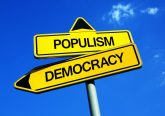Peter Sloterdijk is a German philosopher notorious for his public spat with Jurgen Habermas, his proclamation that critical theory died in the 1990’s (much to the chagrin of Axel Honneth and other contemporary custodians of the tradition), and his gigantic three-volume Spheres trilogy, in which he presents a polemical and holistic philosophy of being, space and nature. The recent English translation of the trilogy has piqued the interest of theorists working on the interdisciplinary problems of culture, ecology and technology. His philosophical anthropology charting of the history of humanity’s self-organisation, specifically his account of “society as foam,” provides an intriguing challenge to the methodological assumptions that underpins much contemporary political theory.
In the third and final volume, Sloterdijk offers a theory of the present age from the perspective that “life” has a space-forming effect: individual living beings are not monads with their own environment but are all intertwined with each other. We are bubbles—translucent, fragile, and co-isolated social units enmeshed in foam, a description intended to capture ‘a technological theory’ of ‘political instructions for the construction and preservation of civilizatory units’ (2016: 37). Foams are described as the:
‘systems or aggregates of spheric neighbourhoods in which each individual “cell” constitutes a self-augmenting context…an intimate space of meaning whose tension is maintained by dyadic and pluripolar resonances, or a “household” that vibrates with its own individual animation (ibid: 52).’
Society is understood as an aggregate of microspheres (spaces of meaning produced by couples, families, households, businesses, free associations, institutions, etc.) that exist and relate to one another in contiguity and propinquity, as ‘individual bubbles in a mountain of foam’ (ibid: 56), both bordering one another and layered above and below one another, without the full transparency and accessibility of absolute disclosure.
The foam metaphor is designed to undermine the suggestion that societies can be understood as organic totalities of homogenous continuity. Instead, societies are only comprehensible as ‘restless and asymmetrical associations of pluralities of space and processes whose cells can neither be truly united nor truly separate’ (ibid: 54). The internal coherence or unity of a given social field is always an ideological construction, a fantasy that operates to suppress the ‘fluid, hybrid, permeable and promiscuous constitution’ (ibid: 55) of societies.
The important aspect of understanding the social field through the foam structure is that it reveals the world-forming aspect of each individual symbolic unit alongside one another, that are then ‘drawn into an interactive network based on the principle of co-isolation’ (ibid:56). The foam metaphor attempts to explain the production of social systems without relying on border-policing or social essentialism.
Throughout Spheres Volume 3: Foams, Sloterdijk wishes to challenge the contractualist (interchangeable with the more common “contractarian”) paradigm, which presupposes a social field comprised of self-interested individuals that organise themselves in a rational process of compromises to secure the formalisation and protection of their pre-existing interests in exchange for a series of duties and obligations to the newly constituted institution. Although contemporary theorists of political obligation often touch on the inherent solidarity involved in human activity (for example, the work of Margaret Gilbert), there is a statist bias to proceedings. The literature is more interested in explaining why the current liberal-democratic settlement is viable, permissible, and legitimately enforceable than it is in the actual historical instantiation of the state and the processes of collective organisation it may be actively impinging upon. If individuals are considered self-interested, ‘social synthesis’ can be explained in dispassionate terms as contractual coordination, without need to allege any ‘mysterious solidarities, deep pre-contractual connections or pre-rational depths of community’. (ibid: 255) As Sloterdijk quips, ‘can I claim to have signed a contract of kinship with my parents and siblings?’ (ibid: 256).
The moment we abandon the contractualist approach and accept that humans have social ties that predate the constitution of political institutions, one must ask in ‘what larger shared structure those coexisting with one another are “contained”, and what nexus actually binds them together’ (ibid: 257) and thus consider the possibility of cohesive forces of pervasive shaping power existing prior to the intervention of the original violence of the constituting state. Although Sloterdijk’s aims are politically conservative (if eccentric), Iwona Janicka (2016) has noted that the foam metaphor complements anarchist theory insofar as it implies a comprehensive solidarity that may plausibly render the state unnecessary under favourable conditions.
In the contractualist model, all those co-existing human beings “lack” for something (usually security) only accessible once they are transformed into “citizens” through the apocryphal manoeuvre from the “state of nature” to “civil society”—an action which ‘none will ever be able to say where, when and in what medium it occurred, and how it could be grounded…no archivist has yet succeeded in finding the cabinet in which the social contract is stored.’ (2016: 268). For Sloterdijk, it is ‘the exquisite nowhere’ in which any social contract is supposedly enacted that deflects away from the material fact of the ‘situate constitution of coexistence and its self-willed spatial dynamics.’ (ibid).
In my view, the novel appeal of Sloterdijk’s “society as foam” is both its implicit and explicit challenge to the norms of political theory. Aside from the explicit denunciation of the contractarian history of political philosophy—epitomised in the work of Hobbes, Locke, and Rousseau—Sloterdijk’s project invites a more spatialised analysis of human activity and political constitution. Instead of focusing on the ways in which we are separate and consider politics as the means by which we are artificially brought together, perhaps political theory ought to focus on those obstacles to sociality that are artificially keeping us apart.
Works Cited:
Iwona Janicka, (2016) “Are these Bubbles Anarchist? Peter Sloterdijk’s Spherology and the Question of Anarchism”, Anarchist Studies, 24:1 (pp.62-84).
Peter Sloterdijk (2016) Spheres, Vol. 3: Foams. South Pasadena, CA: Semiotexte, MIT Press.






